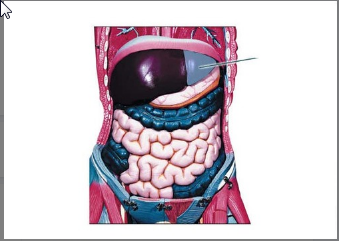A patient's ECG recording shows a very long P-R interval. What is the cause of this abnormal wave pattern?
What will be an ideal response?
The P wave marks the time of atrial depolarization and the QRS complex signals ventricular depolarization. Between those two events the AV node was excited and the action potential was spread through the conducting tissue to the ventricular myocardium. A prolonged P-R interval signifies an unusually slow conduction through the AV node and conducting system, possibly due to insufficient blood flow (ischemia).
You might also like to view...
Which epidermal cell has a role in immunity and disease resistance?
a) Intraepidermal macrophages (Langerhans cells) b) Keratinocytes c) Melanocytes d) Tactile epithelial cells (Merkel cells) e) Podocytes
Identify the highlighted liver lobe.

When bone forms by intramembranous ossification, the ossification centers are within
A. mesenchyme. B. elastic cartilage. C. hyaline cartilage. D. compact bone. E. spongy bone.
Dr. Clark has been lecturing for 3 hours and her ears are beginning to "pop." Which of the following best explains her condition?
A. Inflammation of the inner ear is causing fluid to compress the oval window, leading to the popping noise. B. Inflammation of her larynx is blocking airflow through her external auditory canal, resulting in lack of pressure equilibrium across her oval window. C. Inflammation in her middle ear is causing fluid to build up in the external auditory canal, leading to sudden movement of her tympanic membrane. D. Inflammation of her pharynx is blocking airflow through her auditory tubes, resulting in uneven pressure across her tympanic membranes.